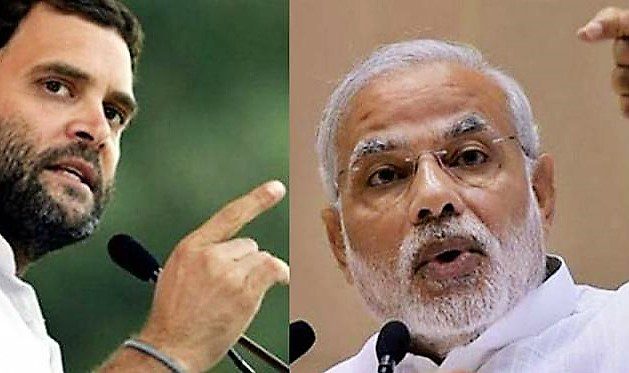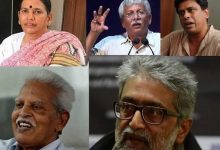Ridicule has become BJP’s weakest weapon against Rahul, while the Congress president is increasingly resorting to stronger political weapons against the policies and decisions of the Modi government. We have seen its effect even during the Gujarat and Karnataka election. The terms of the legislative assemblies of four states – Mizoram, Rajasthan, Madhya Pradesh, and Chhattisgarh – will expire in December and January. The elections are seen as the semi-final contest for the general election to the Lok Sabha, the term of which will expire on May 26, 2019. A report for Different Truths.
In the midst of the BJP’s ridiculing Opposition leader Rahul Gandhi and his becoming stronger day by day, one thing is obvious – greater the ridicule, stronger he becomes. Ridicule has become BJP’s weakest weapon against Rahul, while the Congress president is increasingly resorting to stronger political weapons against the policies and decisions of the Modi government.
We have seen its effect even during the Gujarat and Karnataka elections. The gap that was in 2014 between the political support of Narendra Modi and Rahul Gandhi has all along been reducing. The sinking support base of Modi-Shah duo and increasing political clout of Rahul would be put to test within three months when the four states would face Vidhan Sabha elections, where no other political party is a factor. It would be Modi vs Rahul, and BJP vs INC.
The terms of the legislative assemblies of four states – Mizoram, Rajasthan, Madhya Pradesh, and Chhattisgarh – will expire in December and January. The new government in Mizoram must be in place by December 18 this year. In Chhattisgarh, Madhya Pradesh, and Rajasthan the dates are January 5, January 7, and January 20 respectively next year.
The elections are seen as the semi-final contest for the general election to the Lok Sabha, the term of which will expire on May 26, 2019. The state assembly elections have become important for various reasons, one of which is that barring Mizoram, all the three states are ruled by the Bharatiya Janata Party. Mizoram is ruled by Indian National Congress. The results thus will provide an insight into the political prospect of the INC and the BJP. More so because both parties are pitted against each other in Chhattisgarh, Madhya Pradesh, and Rajasthan. People will come to know which party is becoming stronger, and which is becoming weaker. As for Mizoram, there is no political base for the BJP and, therefore, it is dependent on the performance of its ally.
Anti-incumbency is strongly felt in all the states going for elections. On the one hand, the ruling INC in Mizoram will suffer a ‘single anti-incumbency’, BJP will have to undergo ‘double incumbency’ on account of ruling Chhattisgarh, Madhya Pradesh, and Rajasthan along with ruling at the Centre for the last four and a half years. All the three states have also been witnessing agrarian unrest and demonstrations against the ruling governments for some time now along with unemployed youths who are showing a tendency to be restive against the omissions and commissions of the government at the Centre and the states. Communalism is stronger than casteism in all the four states, on which the BJP is banking upon. They believe that polarization on the line of castes among the Hindus can be upset only by polarisation on the line of communalism.
In Mizoram, Lal Thanhawla of the INC has been ruling the state for two terms. In the decade before, Zoramthanga of Mizo National Front was the chief minister. In the decade before the MNF rule, the INC was ruling the state. This alternating pattern has given hope to the BJP that INC could be ousted this time if they work together with MN, which has declared several times in the recent months that they will not have any pre-poll alliance with the BJP. It is disheartening for the BJP which has committed itself to see a ‘Congress-free India’. The recent claim of BJP president Amit Shah of ‘sweeping northeast polls’ is, therefore, not supported by the ground realities.
Chhattisgarh, after its formation as a separate state in November 2000, was ruled by Ajit Jogi of the Indian National Congress, for only three years upto December 2003. Since then Raman Singh of the BJP is ruling. He will be completing his third term, and most likely will be the chief ministerial candidate seeking re-election for the fourth term. The state is politically divided between the two parties – INC and the Congress. The INC has been suffering due to lack of a formidable leadership for a long time, especially after its main leaders were killed in a naxal attack in 2013. Altogether 27 INC leaders were killed and several others succumbed to injuries. However, in the last five years, the state Congress has become stronger, first due to the efforts of the new leadership of the state, and secondly due to the ever increasing anti-incumbency. The tribal dominated Chhattisgarh has been under the grip of naxalites for a long time, and it has also been reported that many politicians have close connections with them, and they bargain their support during elections.
Shivraj Singh Chouhan, the incumbent chief minister in Madhya Pradesh, has been ruling the state since 2005. He would be seeking re-election as the BJP’s chief ministerial candidate for the third term, if the party leadership decides to field him again. This is the talk of the state because there is a strong group in the state BJP batting against him. They feel that the BJP may lose in the elections if he is fielded again as chief ministerial candidate. This group has close relationships with Modi-Shah duo at the centre. They have been telling the central BJP leadership that the only way out of the ‘strong anti-incumbency’ is to replace Chouhan with some other leader. The then chief minister Uma Bharati was replaced by Babu Lal Gaur in August 2004 in less than a year. Babu Lal Gaur was then replaced by the present chief minister in November 2005 after the BJP won the state’s assembly election. The state has traditionally been INC’s fort which it lost to the BJP after a decade of its rule under the chief ministership of Digvijay Singh between 1993 and 2003. The major cause of INC’s defeat was the rise of Hindutva in the state and the severe infighting in the Congress Party. Both the factors have now somewhat weakened, giving hope to the INC to snatch the reign of the state from the BJP.
Rajasthan is most likely to witness a fierce battle between the INC and the BJP. Both the parties have considerable support base of their own. Since 1993, both the parties are ruling the state alternately. The BJP came to power for the first time in the state after the rise of Hindutva forces in the 1990 by snatching the reign traditionally held by the INC. Bhairon Singh Shekhawat became the first chief minister of the BJP. The state came under President’s rule between December 1992 and December 1993, ie after the demolition of the Babri Mosque in Ayodhya. He again became chief minister in 1993 for one term. INC came to power in 1998, BJP in 2003, INC in 2008, and BJP in 2013. If this alternating patter of the people’s preference is continued, the INC may be the next winner. The incumbent chief minister will have sleepless nights ahead because of the prospect of losing, not only on this alternating preference, but also the double incumbency, infighting, agrarian unrest, and the ire of the disillusioned youth on account of ever rising unemployment.
Gyan Pathak
©IPA Service
Photo from the Internet





 By
By
 By
By

 By
By